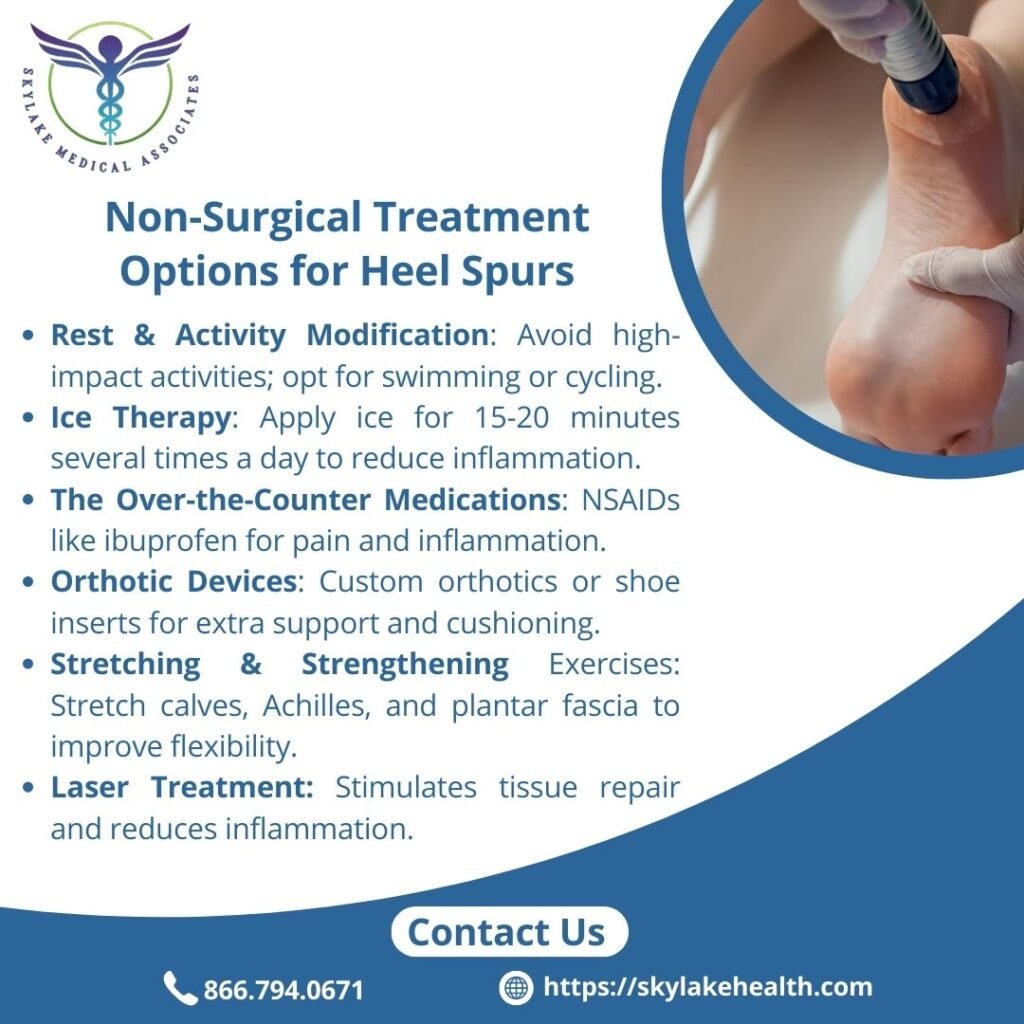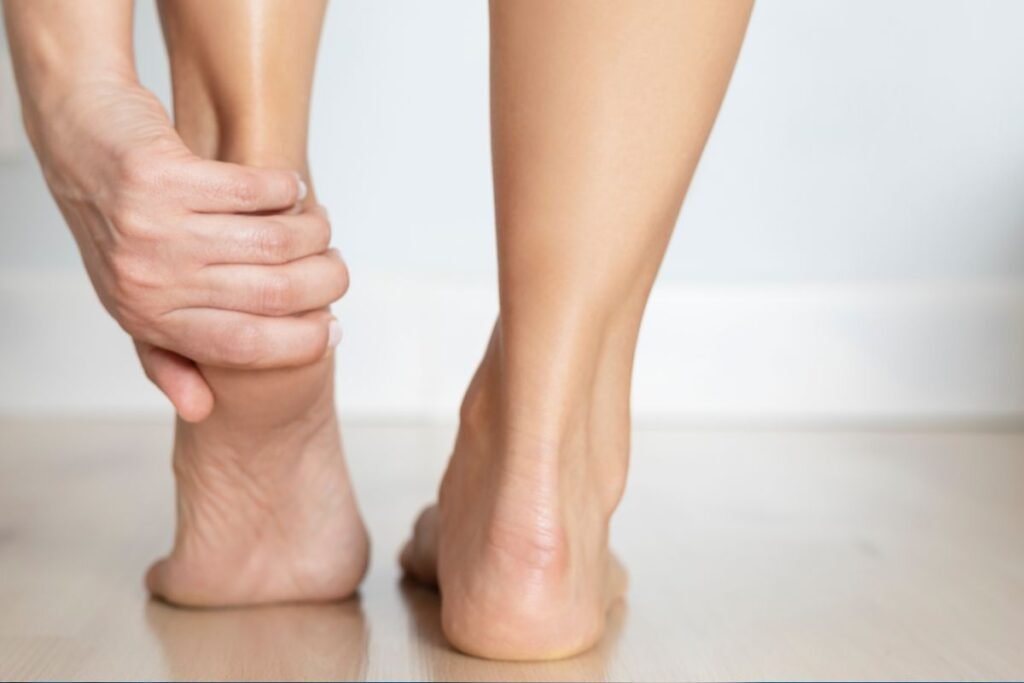Heel pain can be a frustrating and limiting condition, especially for runners, athletes, and individuals with flat feet or high arches. However, it can affect anyone—whether you spend long hours on your feet, lead an active lifestyle, or simply wear unsupportive footwear.
One common cause of chronic heel pain is a heel spur, a bony growth that develops on the bottom of the heel bone due to prolonged stress on the foot. While some people with heel spurs experience no discomfort, others suffer from sharp pain, particularly in the morning or after long periods of rest. If left untreated, this pain can worsen, making daily activities and exercise increasingly difficult.
In this article, we’ll explore what heel spurs are, how they relate to plantar fasciitis and effective non-surgical treatment options. We will also discuss when it’s time to consult a podiatrist and the benefits of seeking professional evaluation from a podiatrist. If you’re struggling with persistent heel pain, keep reading to learn how to find lasting relief.

What Are Heel Spurs?
Heel spurs are calcium deposits that build up on the underside of the heel bone over time. They are typically the result of chronic stress on the foot muscles and ligaments and are often associated with conditions that lead to long-term inflammation. Although the spur itself is a bony protrusion, pain usually occurs when the spur irritates the surrounding soft tissue, particularly the plantar fascia. Not every heel spur causes symptoms, but when discomfort is present, it can significantly impact mobility and quality of life.
Common Causes and Symptoms
The development of heel spurs is linked to several risk factors. Repetitive stress from activities such as running, dancing, or prolonged standing can contribute to their formation. Wearing shoes that do not offer proper arch support or cushioning further exacerbates the problem. Additionally, individuals with flat feet or high arches experience biomechanical imbalances that place extra strain on the heel. Obesity also increases the risk, as extra body weight puts additional pressure on the foot.
Symptoms associated with heel spurs often include sharp pain in the heel—especially during the first steps in the morning or after extended periods of inactivity—swelling around the heel, and tenderness when pressure is applied. In some cases, the pain may subside with movement only to return later, making it a persistent and often worsening issue over time.
Heel Spurs vs. Plantar Fasciitis: Understanding the Connection
Although heel spurs and plantar fasciitis are frequently mentioned together, they are distinct conditions that often coexist. Plantar fasciitis is characterized by inflammation of the plantar fascia, the thick band of tissue that runs from the heel to the toes. This inflammation is usually most painful in the early morning or after long periods of rest, as the tissue tightens and then stretches with movement.
The chronic inflammation seen in plantar fasciitis can lead the body to deposit calcium on the heel bone, resulting in a heel spur. However, it’s important to note that a heel spur itself may not cause pain; rather, it is the surrounding inflammation and irritation that typically result in discomfort.
In some individuals, plantar fasciitis may occur without the development of a heel spur, and vice versa. Understanding this relationship is crucial for devising an effective treatment plan that addresses both the bony abnormality and the soft tissue inflammation.

Non-Surgical Treatment Options for Heel Spurs
For many individuals, conservative, non-surgical treatments provide significant relief from heel spur pain. Some of the most effective strategies include:
Rest and Activity Modification:
Reducing high-impact activities that place stress on the heel is crucial. Opting for lower-impact exercises, such as swimming or cycling, can help minimize pain while maintaining fitness.
Ice Therapy:
Applying an ice pack to the affected area for 15 to 20 minutes several times a day can help reduce inflammation and numb pain.
Over-the-Counter Medications:
Nonsteroidal anti-inflammatory drugs (NSAIDs) like ibuprofen can be effective in reducing pain and inflammation.
Orthotic Devices:
Using custom orthotics or over-the-counter shoe inserts provides additional arch support and cushioning, helping to redistribute pressure away from the heel. This is particularly beneficial for those with flat feet or high arches.
Stretching and Strengthening Exercises:
Regularly performing targeted stretches for the calf muscles, Achilles tendon, and plantar fascia can improve flexibility and reduce tension. A foot and ankle doctor may recommend specific exercises as part of a physical therapy program to enhance recovery.
Laser Treatment:
Advanced laser treatment can help reduce inflammation and promote healing by stimulating tissue repair at the cellular level.
When to See a Podiatrist
If you find that conservative treatments are not providing sufficient relief, or if your heel pain is severe enough to interfere with daily activities, it is important to consult a professional. Persistent pain, swelling, or difficulty walking should prompt a visit to a podiatrist in North Miami Beach.
A thorough evaluation—often including physical examinations and imaging studies like X-rays—can help pinpoint the exact cause of your pain, whether it is due to a heel spur, plantar fasciitis, or another underlying condition. In cases where non-surgical treatments fail to alleviate the symptoms, more advanced interventions such as foot and ankle surgery may be considered as a last resort.
The Role of a Foot and Ankle Doctor
A skilled foot and ankle doctor is essential for managing complex foot conditions. By conducting comprehensive evaluations and developing personalized treatment plans, these specialists address both the symptoms and root causes of heel pain.
Their expertise is especially important when conservative treatments do not yield the desired results, ensuring that patients receive the most effective care possible.
Whether recommending a targeted exercise regimen or considering advanced treatment options like laser treatment, a dedicated specialist can make a significant difference in your recovery.
Why Choose Skylake Medical Associates for Your Foot Care?
At Skylake Medical Associates, we provide expert care for a wide range of foot and ankle conditions, including heel spurs and plantar fasciitis. Under the leadership of Dr. Dmitry Sandler, our team of experienced professionals is dedicated to delivering personalized treatment plans designed to relieve pain and restore mobility.
Dr. Sandler’s extensive experience treating patients from Dade, Broward, and Palm Beach counties ensures that you receive high-quality care that is both compassionate and effective. We utilize state-of-the-art techniques, including advanced Laser Treatment, to promote healing and reduce recovery time.
In addition, our services extend to diabetic foot care in North Miami Beach, as well as wound and limb care salvage, ensuring that even patients with complex conditions receive comprehensive support.
Trusted by Patients, Proven by Results
At Skylake Medical Associates, we take pride in the exceptional care we provide, and our patients’ testimonials speak for themselves. Many have found lasting relief under the expert guidance of Dr. Dmitry Sandler and his dedicated team.
“Thanks to Dr. Sandler and Skylake Medical Associates, I can finally walk pain-free,” shares Abel Rubinovich. Others, like Ann, express deep appreciation, saying, “After struggling with persistent foot pain and consulting various specialists without success, I finally found relief under Dr. Sandler’s care.”
Patients highlight not only the medical expertise but also the welcoming atmosphere, with Fiona Trani noting, “The front desk staff was so kind and helpful, and the doctors were incredibly attentive and knowledgeable.”
These are just a few of the many voices who trust Skylake Medical Associates for their foot and ankle care. Let us help you take the next step toward a pain-free life.

Take the First Step Toward Relief
If heel pain is slowing you down, it’s time to take action. Whether you’re dealing with a heel spur, plantar fasciitis, or another foot condition, Skylake Medical Associates is here to help.
Don’t let heel pain control your life—get back on your feet today with expert care from our dedicated team. Contact us now to schedule an appointment and start your journey toward a pain-free future.
***
The material contained on this site is for informational purposes only and DOES NOT CONSTITUTE THE PROVIDING OF MEDICAL ADVICE, and is not intended to be a substitute for independent professional medical judgment, advice, diagnosis, or treatment. Always seek the advice of your physician or other qualified healthcare providers with any questions or concerns you may have regarding your health.

